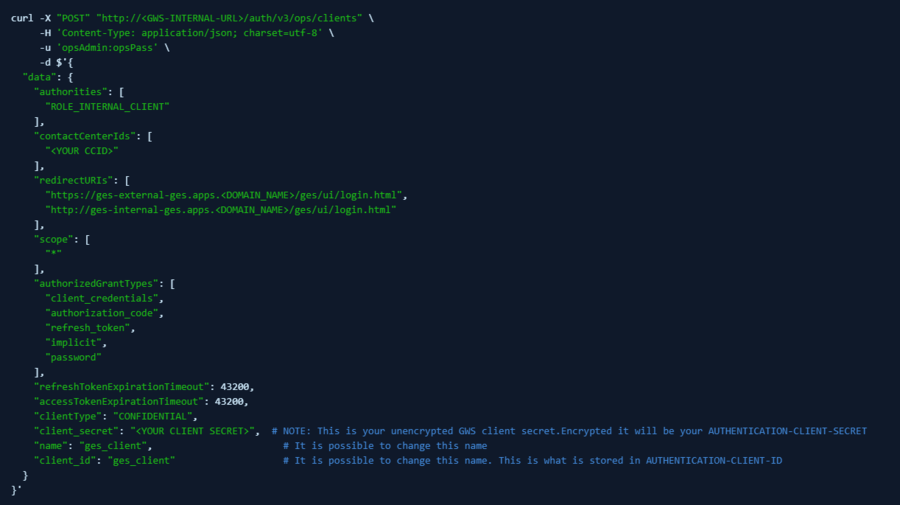Difference between revisions of "PEC-CAB/Current/CABPEGuide/Deploy"
(Published) |
m (Text replacement - "Genesys Engage" to "Genesys Multicloud CX") |
||
| Line 1: | Line 1: | ||
{{Article | {{Article | ||
|Standalone=No | |Standalone=No | ||
| − | |DisplayName=Deploy Genesys | + | |DisplayName=Deploy Genesys Multicloud CXment Service |
| − | |Context=Learn how to deploy Genesys | + | |Context=Learn how to deploy Genesys Multicloud CXment Service. |
|ComingSoon=No | |ComingSoon=No | ||
|Section={{Section | |Section={{Section | ||
|alignment=Vertical | |alignment=Vertical | ||
| − | |structuredtext={{NoteFormat|Make sure to review {{Link-SomewhereInThisVersion|topic=Planning}} for the full list of prerequisites required to deploy Genesys | + | |structuredtext={{NoteFormat|Make sure to review {{Link-SomewhereInThisVersion|topic=Planning}} for the full list of prerequisites required to deploy Genesys Multicloud CXment Service.|}} |
For solution-level deployment information, see {{SuiteLevelLink|openshift}}. | For solution-level deployment information, see {{SuiteLevelLink|openshift}}. | ||
| Line 14: | Line 14: | ||
|anchor=DeployService | |anchor=DeployService | ||
|alignment=Vertical | |alignment=Vertical | ||
| − | |structuredtext=#Because Genesys | + | |structuredtext=#Because Genesys Multicloud CXment Service (GES) relies on other services, you must ensure that the following have been deployed and configured successfully before you deploy GES: |
#*Voice Microservices | #*Voice Microservices | ||
#*Designer | #*Designer | ||
| Line 74: | Line 74: | ||
|alignment=Vertical | |alignment=Vertical | ||
|structuredtext====Create a callback=== | |structuredtext====Create a callback=== | ||
| − | There are two ways to create a callback request as an external user. You can create a callback request from the Callback UI or by using the /engagement API. For information about using the Callback UI to create a callback, see {{Link-AnywhereElse|product=PEC-CAB|version=Current|manual=Administrator|topic=ManagingCallbacks|display text=Managing callbacks}}. For information about using the APIs, see {{Link-AnywhereElse|product=PEC-CAB|version=Current|manual=Administrator|topic=CallbackRESTAPIsandTutorials|display text=Genesys | + | There are two ways to create a callback request as an external user. You can create a callback request from the Callback UI or by using the /engagement API. For information about using the Callback UI to create a callback, see {{Link-AnywhereElse|product=PEC-CAB|version=Current|manual=Administrator|topic=ManagingCallbacks|display text=Managing callbacks}}. For information about using the APIs, see {{Link-AnywhereElse|product=PEC-CAB|version=Current|manual=Administrator|topic=CallbackRESTAPIsandTutorials|display text=Genesys Multicloud CX REST APIs and tutorials for Callback}}. |
|Status=No | |Status=No | ||
}}{{Section | }}{{Section | ||
Revision as of 21:12, November 9, 2021
Contents
Learn how to deploy Genesys Multicloud CXment Service.
For solution-level deployment information, see [[PrivateEdition/Current/PEGuide/GetStarted|]].
Deploy the service
- Because Genesys Multicloud CXment Service (GES) relies on other services, you must ensure that the following have been deployed and configured successfully before you deploy GES:
- Voice Microservices
- Designer
- GWS
- Agent Setup (you require Agent Setup to create user logins for GES and to assign the necessary privileges)
- Create dedicated Redis and Postgres instances for GES. Note the hostname and the credentials to authenticate and then provision Kubernetes secrets to store the following:
- REDIS-CACHEKEY
- DB-USER
- DB-PASSWORD
- Create the GES project/namespace:
- This will differ between environments. Be sure to check the instructions specific to the environment in Deploy in OpenShift.
- Provision a set of GWS client credentials for GES. You can do this with the following
curlcommand. - Provision secrets for GES:
- For more information about how GES leverages secrets and how they can be provisioned, see the secrets section.
- Create the Helm values file:
- Using information in the Override Helm chart values section, create a Helm values file that describes the details of your GES deployment, secrets, and environment.
- A base Helm values file is included with the GES Helm charts that you receive from Genesys. The GES base file uses the filename,
ges-base-values.yaml.
- Install the GES Helm charts.
- Validate the GES helm charts using:
> helm upgrade --install --dry-run -n <GES_NAMESPACE> -f <path/to/values.yaml> <GES_RELEASE_NAME> <PATH_TO_GES_HELM_CHART>- Review the output to ensure that the generated Helm manifest matches your expectations.
- Install the GES Helm charts:
> helm upgrade --install -n <GES_NAMESPACE> -f <path/to/values.yaml> <GES_RELEASE_NAME> <PATH_TO_GES_HELM_CHART>
Deploy in OpenShift
Validate the deployment
Once GES has been installed and provisioned following the processes outlined above the best way to do that is to check that Callback and another provisioned services work as intended. In addition, logging in to the UI is a good way to check that privileges are working as well as monitor that callbacks, call ins and other requests have been made successfully.
Validate the UI
Login to the UI.
With a user that has been assigned the Callback Administrator role, attempt to log into the Callback UI. You can do this at <GES_DOMAIN_NAME>/ges.
If you successfully log in, then you see an empty Callback grid as the main feature of the screen:
Navigate to some of the other tabs and verify that no errors pop up in the lower corner of the screen as the system attempts to read and retrieve data.
If, at any point, data fails to load or you are locked out due to insufficient permissions, adjust the roles and privileges assigned to Callback UI users and try again.
Create a callback
There are two ways to create a callback request as an external user. You can create a callback request from the Callback UI or by using the /engagement API. For information about using the Callback UI to create a callback, see Managing callbacks. For information about using the APIs, see Genesys Multicloud CX REST APIs and tutorials for Callback.
Create Call-In request (optional)
The Click-to-Call-In scenario is optional functionality. If you plan to use the Click-to-Call-In feature, see the following pages for more information:



